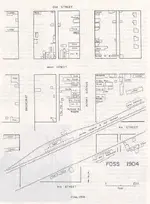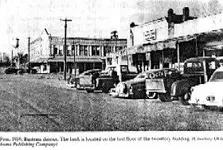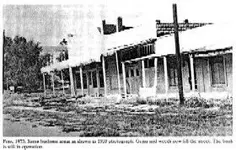Gypsy Heart
Gold Member
- #1
Thread Owner
Some 15 miles west of Clinton, Oklahoma is yet another town that “bit the dust” at the hands of Superhighway I-40. Foss, Oklahoma got its start in the late 1890s when people began to populate the valley of Turkey Creek. However, when a flash flood occurred on May 2, 1902, it pretty much wiped out the town, washing buildings away and drowning several people.
Not tempting Mother Nature again, the surviving residents moved out of the creek bottom to higher ground and the new town was called Foss. The fertile farmland surrounding the area attracted many early settlers and Foss grew to a population of almost 1000 people by 1905. Soon all manner of businesses sprang up including two banks and three cotton gins. Stone buildings replaced earlier frame structures, a school system was organized, and several churches were built. By 1912, Foss had an electric plant, two hotels and an opera house.
After the town’s initial rapid growth it stabilized at about 500 people. However, in the 1920's the town began to struggle as the nearby rail centers of Clinton and Elk City began to absorb much of the town’s former trade.
Later, the depression and the Dust Bowl of the 1930’s created further migration from the area. Still, the small town hung on and in the 1950's saw a revival due to the increased use of the Air Force Installation at nearby Burns Flat. However, the base closed at about the same time that Foss was bypassed by I-40 and those few remaining people began to leave. Finally, in September, 1977, the one bank left open in Foss closed its doors forever.
Foss is a town in Washita County, Oklahoma, United States. During World War II, the town boasted a population of over 300 residents, relying primarily on Route 66 travellers (which passed half a mile south of the city) and a U.S. naval base south of the town that operated during war time. A gas station and a café also operated in the town around that time. As of the United States Census, 2000, the town population was 127.
Foss is located at 35°27′12″N, 99°10′15″W
Not tempting Mother Nature again, the surviving residents moved out of the creek bottom to higher ground and the new town was called Foss. The fertile farmland surrounding the area attracted many early settlers and Foss grew to a population of almost 1000 people by 1905. Soon all manner of businesses sprang up including two banks and three cotton gins. Stone buildings replaced earlier frame structures, a school system was organized, and several churches were built. By 1912, Foss had an electric plant, two hotels and an opera house.
After the town’s initial rapid growth it stabilized at about 500 people. However, in the 1920's the town began to struggle as the nearby rail centers of Clinton and Elk City began to absorb much of the town’s former trade.
Later, the depression and the Dust Bowl of the 1930’s created further migration from the area. Still, the small town hung on and in the 1950's saw a revival due to the increased use of the Air Force Installation at nearby Burns Flat. However, the base closed at about the same time that Foss was bypassed by I-40 and those few remaining people began to leave. Finally, in September, 1977, the one bank left open in Foss closed its doors forever.
Foss is a town in Washita County, Oklahoma, United States. During World War II, the town boasted a population of over 300 residents, relying primarily on Route 66 travellers (which passed half a mile south of the city) and a U.S. naval base south of the town that operated during war time. A gas station and a café also operated in the town around that time. As of the United States Census, 2000, the town population was 127.
Foss is located at 35°27′12″N, 99°10′15″W






